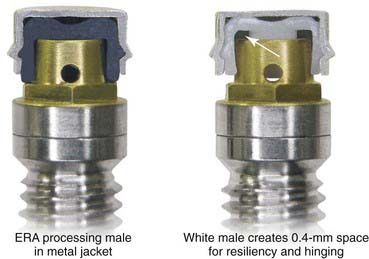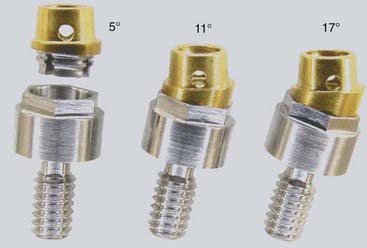Chapter 27 Minimally Invasive Implant Esthetics
Relevance of Minimally Invasive Implant Stabilization to Esthetic Dentistry
Brief History of the Clinical Development of Minimally Invasive Implant Stabilization
The ERA® attachment (Sterngold Dental, Attleboro, Massachusetts, Figure 27-1) has been available for many years and was miniaturized and adapted to these smaller implants. The ERA®mini implant (an ERA abutment incorporated onto a 2.2 or 3.25 mm diameter implant) enables the clinician to place implants in areas that are too atrophic for traditional implants. Thus making it possible to treat many more patients in whom the remaining bone width is insufficient to support conventional implants without extensive bone grafting. The ERA®mini implant’s ability to alter the path of insertion and negate the need for a bar in the maxilla, has opened the door to these smaller implants in the maxilla where minimal bone is present, often without additional bone grafting. The success rate of the ERA®mini implants is equal to that of the larger implants in the over denture application primarily due the ability of the ERA® attachment to alter the path of insertion which significantly reduces forces placed on the implant. The ERA® supported denture, whether on conventional or smaller ERA®mini implants, creates a tissue-supported implant-retained prosthesis. Patients who were not eligible for the treatment previously can now proceed with a less invasive and significantly more economical technique. Once a stabilizing platform has been achieved (implant support) and the teeth can be replaced on a denture, the limitations previously caused by a lack of stabilization for the dentures no longer apply.
Material Options
Advantages
It is better to place a smaller implant in adequate bone than to place a larger implant where the bone is very thin. Because the maxilla is addressed and bars are not being used, it is necessary to use an attachment that will allow for alteration of the path of insertion. Currently only the ERA® Attachment System (Sterngold Dental) has the ability to alter the path of insertion (Figure 27-2) and create vertical resiliency with multiple retentive strengths (see Figures 27-1 and 27-2). The other small attachments on the market are appropriate only in situations in which the implants are parallel. If the implants can be positioned parallel, almost anything can serve as an attachment. If the osseous contour makes it impossible for the implants to be placed parallel, only the ERA® attachment will alter the path of insertion sufficiently to enable it to be made parallel.
Innovative Elements
Scientific
The attachment used has resiliency, allows alteration of the path of insertion, and has multiple retentive strengths. This innovation makes it is possible to retrofit the existing denture or a new denture. The implants continue to function as long as the patient needs them. The ERA®mini implant was created by combining a micro ERA® attachment with a smaller implant of the same material makeup as the conventional implant and an aggressive self-tapping thread design. Where the bone is not dense, under-sizing the osteotomy, an effect much like squeezing a sponge (making the sponge denser), is achieved. In maxillary areas where the bone is not of good quality, better bone quality is created by condensing the bone around the implant as it taps its way into the spongy bone. The implant-bone interface is much denser then the surrounding bone and provides stability during the healing phase. Altering the path of insertion, without incorporating detrimental forces of mastication, will correct for misalignment (see Figure 27-2).
Stay updated, free dental videos. Join our Telegram channel

VIDEdental - Online dental courses




